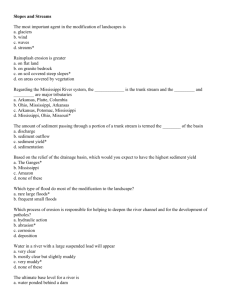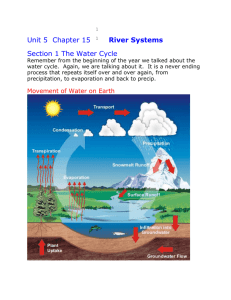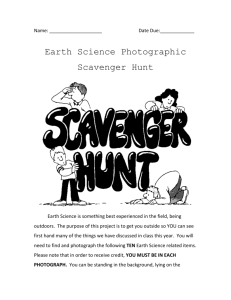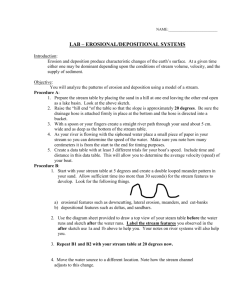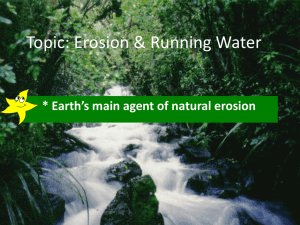Erosion Lab
advertisement
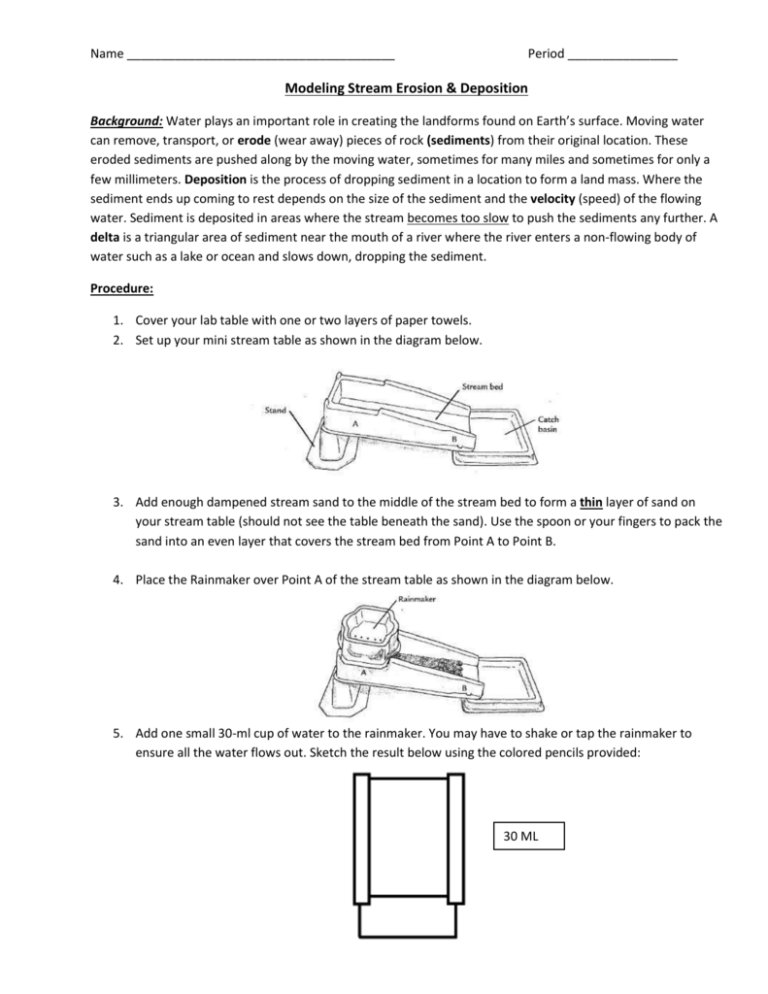
Name _______________________________________ Period ________________ Modeling Stream Erosion & Deposition Background: Water plays an important role in creating the landforms found on Earth’s surface. Moving water can remove, transport, or erode (wear away) pieces of rock (sediments) from their original location. These eroded sediments are pushed along by the moving water, sometimes for many miles and sometimes for only a few millimeters. Deposition is the process of dropping sediment in a location to form a land mass. Where the sediment ends up coming to rest depends on the size of the sediment and the velocity (speed) of the flowing water. Sediment is deposited in areas where the stream becomes too slow to push the sediments any further. A delta is a triangular area of sediment near the mouth of a river where the river enters a non-flowing body of water such as a lake or ocean and slows down, dropping the sediment. Procedure: 1. Cover your lab table with one or two layers of paper towels. 2. Set up your mini stream table as shown in the diagram below. 3. Add enough dampened stream sand to the middle of the stream bed to form a thin layer of sand on your stream table (should not see the table beneath the sand). Use the spoon or your fingers to pack the sand into an even layer that covers the stream bed from Point A to Point B. 4. Place the Rainmaker over Point A of the stream table as shown in the diagram below. 5. Add one small 30-ml cup of water to the rainmaker. You may have to shake or tap the rainmaker to ensure all the water flows out. Sketch the result below using the colored pencils provided: 30 ML Name _______________________________________ Period ________________ 6. Add another 30-ml cup of water to the Rainmaker and sketch the results below: 60 ML 7. Add a third 30-ml cup of water to the Rainmaker and sketch the results below: 90 ML 8. Begin to clean up by scraping as much of the sand as possible back into the sand container. Bring the stream table to Ms. Luancing or your co-teacher to finish cleaning off the sand. Return your spoon and colored pencils to the green bin. Wipe off your lab table and throw away all paper towels. Analysis Questions: ** Read the background on the 1st page before answering the questions!! 1. Describe the major changes that occurred each time 30 mL of “rain” fell on the stream bed. ______________________________________________________________________________________ ______________________________________________________________________________________ 2. Define erosion. ______________________________________________________________________ ______________________________________________________________________________________ Name _______________________________________ Period ________________ 3. Where did the greatest amount of erosion occur? Explain why more erosion takes place in this location. ______________________________________________________________________________________ ______________________________________________________________________________________ ______________________________________________________________________________________ ______________________________________________________________________________________ 4. Define deposition.___________________________________________________________________ ______________________________________________________________________________________ 5. Where did the greatest amount of deposition occur? Explain why more deposition takes place in this location. _____________________________________________________________________________________ ______________________________________________________________________________________ ______________________________________________________________________________________ ______________________________________________________________________________________ 6. What two factors cause rivers to flow in the direction that they do? ___________________________ _____________________________________________________________________________________ 7. Look at the diagram below. Where would the river have the greatest velocity? Shade the area with your pencil. Where would it have the least velocity? Stripe it with your pencil. How do you know that its velocity is highest there? (explain on the lines) Direction of river flow. Name _______________________________________ Period ________________ #7 Explanation: _______________________________________________________________________ _____________________________________________________________________________________ _____________________________________________________________________________________ 8. Define delta and explain why deltas form in the locations that they do. _____________________________________________________________________________________ _____________________________________________________________________________________ ______________________________________________________________________________________ ______________________________________________________________________________________ 9. Label the delta on your 90 ML sketch on page 2. 10. If you wanted to prevent erosion on the banks of a major river what could you do? Be specific and list at least three things. 1.____________________________________________________________________________________ 2.____________________________________________________________________________________ 3. _____________________________________________________________________________________ ______________________________________________________________________________________




